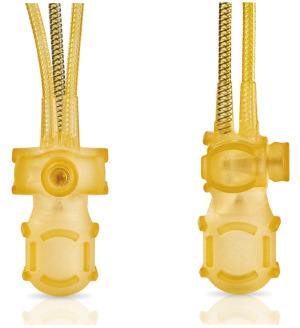Reflections from practice: innovations in inflatable penile prosthesis pumps benefit both patients and physicians

Tactile feedback and improved ease of use are good for a patient—for their confidence, spontaneity, and overall experience. These features also result in a less burdensome teaching experience for urology staff. The TENACIO Pump has a higher profile deflation button and a greater separation between the deflation button and pump bulb compared to any IPP pump previously or currently available (Figure 1), without the pump being larger than its predicate, the Momentary Squeeze (MS) Pump™. In my view, these features will significantly minimize the problem of a patient inadvertently pressing the deflation button during inflation. The prominent exterior grips and deflation buttons that guide finger placement are advantageous to an aging population affected by decreased dexterity. The independent valve function for inflation and deflation (unidirectional flow) seems likely to decrease pump failures.
In my initial cases implanting the AMS 700 with the TENACIO Pump since FDA approval, I have observed that while the implanting experience is not different from the MS Pump (because the size difference is negligible), the new design features are noticeable. Inflation squeezes are more reproducible than with the MS, and the TENACIO Pump refills faster than its predecessor. Since performing cases on the first day of TENACIO’s U.S. availability on June 10, 2024, I have seen 22 patients who have completed their 4-week follow-up visits. Seven of these cases were penile implant replacement procedures from AMS 700 with MS Pump to the AMS 700 with TENACIO Pump. Replacement patients have commented on the ease of identifying inflation pump bulb and deflation button, as well as noticing the quicker pump bulb refill rate. Naïve patients are easily identifying the deflation button. Only two naïve patients so far have required reeducation in order to achieve desired cylinder rigidity.
Improvement in IPP component design is of continued importance to our patients and to our own practice, and I eagerly look forward to the clinical outcomes from studies that include the TENACIO Pump.
Footnote
Provenance and Peer Review: This article was a standard submission to the journal. The article has undergone external peer review.
Peer Review File: Available at https://tau.amegroups.com/article/view/10.21037/tau-24-353/prf
Conflicts of Interest: The author has completed the ICMJE uniform disclosure form (available at https://tau.amegroups.com/article/view/10.21037/tau-24-353/coif). The author reports that he is a consultant for Boston Scientific, including teaching. The author has no other conflicts of interest to declare.
Ethical Statement: The author is accountable for all aspects of the work in ensuring that questions related to the accuracy or integrity of any part of the work are appropriately investigated and resolved.
Open Access Statement: This is an Open Access article distributed in accordance with the Creative Commons Attribution-NonCommercial-NoDerivs 4.0 International License (CC BY-NC-ND 4.0), which permits the non-commercial replication and distribution of the article with the strict proviso that no changes or edits are made and the original work is properly cited (including links to both the formal publication through the relevant DOI and the license). See: https://creativecommons.org/licenses/by-nc-nd/4.0/.
References
- Scott FB, Bradley WE, Timm GW. Management of erectile impotence. Use of implantable inflatable prosthesis. Urology 1973;2:80-2. [Crossref] [PubMed]
- May E, Hanley M, Mulcahy JJ, et al. Technological advances in penile implants: past, present, future. Int J Impot Res 2023;35:629-33. [Crossref] [PubMed]
- Kessler A, Sollie S, Challacombe B, et al. The global prevalence of erectile dysfunction: a review. BJU Int 2019;124:587-99. [Crossref] [PubMed]
- Fernandez-Crespo RE, Buscaino K, Carrion R. “Pumpology”: the Realistic Issues Associated with Pump Placement in Prosthetic Surgery. Curr Urol Rep 2021;22:10. [Crossref] [PubMed]
- Kavoussi NL, Viers BR, VanDyke ME, et al. “Stiction Syndrome”: Non-Operative Management of Patients With Difficult AMS 700 Series Inflation. J Sex Med 2017;14:1079-83. [Crossref] [PubMed]
- Garber BB, Khurgin JL, Stember DS, et al. Pseudo-malfunction of the Coloplast Titan Inflatable Penile Prosthesis One-Touch Release Pump. Urology 2014;84:857-9. [Crossref] [PubMed]
Correspondence to: L. Dean Knoll, MD. Men’s Health Clinic, Prosthetic Urology, Urology Associates of Nashville, 2801 Charlotte Avenue, Nashville, TN 37209, USA. Email: dknoll23@yahoo.com.